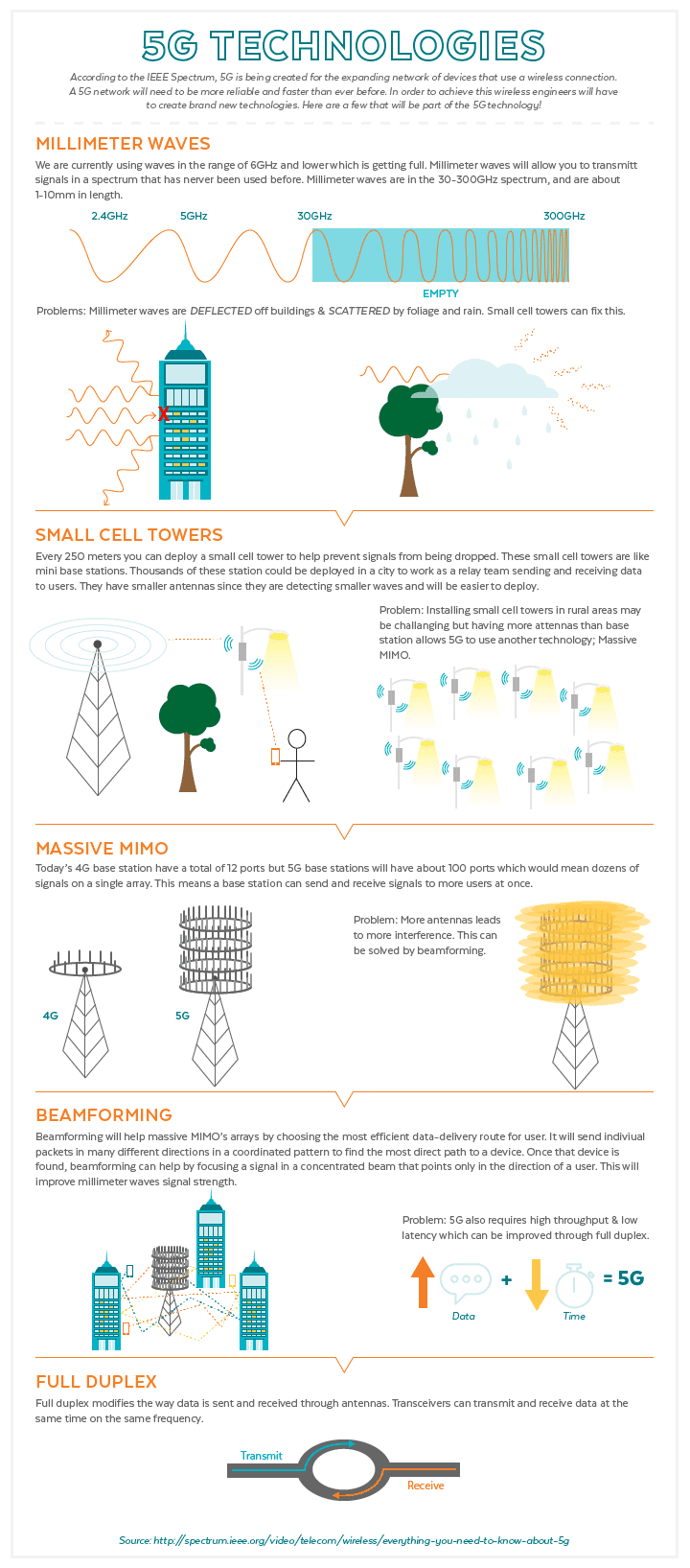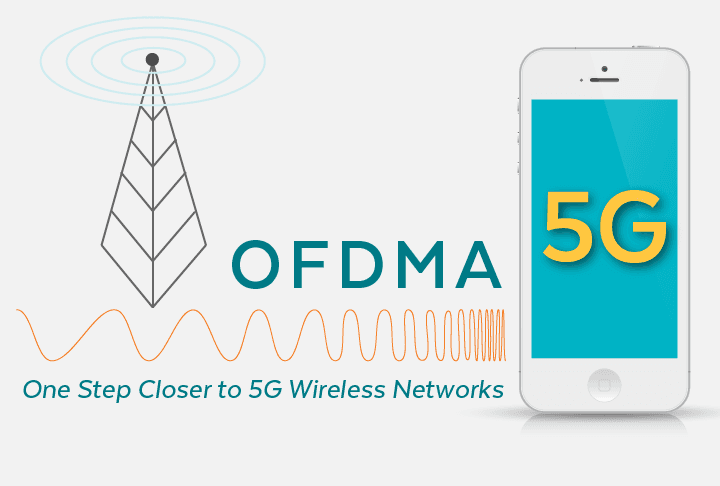Most wireless users today connect over 4G technology.
There’s a lot to love about 4G, the least of which is that it’s substantially faster than 3G.
The increased bandwidth allows us to stream quality video and much much more. But with so many people accessing larger quantities of data every minute, we’ve just about maxed out our capacity.
It won’t be long before wireless users will find themselves in need of even larger data consumption capability.
That’s due to the upcoming introduction of mainstream Virtual Reality, Self-Driving Vehicles, and the roughly 20B other devices set to connect over Wi-Fi over the next 5 years.
The long and short of it is: we’re going to need faster data transfer speeds.
Enter 5G. Of course, 5G is still a ways out. And what it will ultimately end up looking like is still relatively unclear. But we do know that it will include:
- Millimeter Waves
- Many Small Cell Towers
- Massive MIMO
- Beam Forming
- Full Duplex

5G has its own set of challenges to overcome, but experts say it’ll have the ability to process up to 1000x more traffic than 4G can handle.
In the meantime, a new low power, high efficiency Wi-Fi is on the horizon. IEEE 802.11ax.
Thanks to this new high-efficiency Wi-Fi protocol, current frustration factors over jumping on wireless networks just went down a few clicks. This version of Wi-Fi offers some great features that’ll make connecting with your cell phone in particular, a lot easier.
One of the key features driving this connectivity improvement is Orthogonal Frequency-Division Multiple Access (OFDMA). This multiplexing digital modulation scheme introduces newfound permeability into highly dense Wi-Fi traffic scenarios.
Let’s take a closer look.
The Physics of Sound Waves
Frequency waves can be measured in length. Obviously, or 5G “millimeter” waves wouldn’t be a new feature. As you probably are already aware, wavelength impacts how fast and far sound or data can travel.
For an example of how powerful this is, look no further than the mighty whale. The blue whale make calls between 10 and 40 Hz and lasting between 10 and 20 seconds. (The lowest frequency sound a human can hear, incidentally, is 20 Hz).
A single 10 Hz wave is an astonishing 17 meters long. In a perfect environment (which includes cooler temperatures), whale frequency waves can travel up to 1400 meters per second. When you do the math, it shows that amazingly a blue whale can hear other blue whales crying from over 26 miles away.
Now imagine you could attach a bunch of sub waves to those powerful 10 Hz whale cries. You could literally push those subwaves that 26 miles along with the whale cries. And, with 17 meters to play with, you’d have a lot of room to do just that.
As in sound waves, this same principle applies for radio waves.
OFDMA Offers High Spectral Efficiency
The secret to OFDMA is that it takes advantage of all of that real estate on each and every wave. The key is granularity.
Wi-Fi traditionally operates over frequencies of 6 GHz and below. Carriers have recently had challenges with cramming the increasing numbers of devices onto this somewhat narrow frequency spectrum.
With more devices connecting to networks, service slows and connections can even drop. With OFDMA, multiple users are assigned access to subsets or subcarriers.
The ability to tap into smaller segments of the frequency spectrum with timed functionality will become even more important in 5G, where data will travel on millimeter waves.
How Subcarrier Waves Work
You can fit a lot of subcarrier waves in between carrier waves. Employing timed, millimeter-sized waves will allow 5G technologies to take advantage of even more.
With 5G, simultaneous low data rate transmissions will also be able to travel over the same frequency in both directions without delays. Uplink and downlink signals can travel simultaneously without interference.
How Frequency Division Multiplexing (FDM) Works
In FDM, bandwidth available in a communication medium divides into non-overlapping frequency sub-bands. All frequency resources are allocated for a single user. In each timed segment, one user gets the full allocation of the sub-band.
In OFDMA, timed bands are actually divided between multiple users.
The ORTHOGONAL aspect controls the timing of bands so that no signals or data interfere with other signals sharing the same frequency.
Guard bands, normally employed between channels to prevent waves from clashing and cancelling each other out, are no longer necessary. This frees up even more space on each wave.
Greater granularity becomes available and can be attributed to the synchronized timing of the other signals sharing the same frequency band.
Where OFDMA Gets Used in 4G
Places where you’ll find it used right now:
- Digital TV
- Audio Broadcast
- DSL Internet
- Wireless Networks
- Powerline Networks
- 4Gmobile communications
OFDMA is actually a proprietary name. But much like the term KLEENEX, engineers use the terminology OFDMA in most instances.
Conclusion
We’re not there yet. 5G requires the support of a different type of infrastructure.
Instead of single, far-flung cell towers, providers will need to position smaller units in a mesh-like configuration to support these different millimeter waves. But each month brings exciting advances that lead us ever closer to a workable 5G network.
If you’d like to learn more about what OFDMA can do, stay tuned for more information on 802.11ax as it will be brought to market sooner than 5G.

